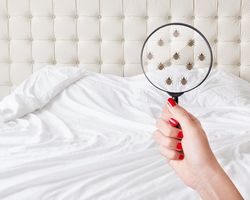Traveler's tip: Check your room for bedbugs

Dec. 16, 2022—After a long day of traveling, relaxing in a comfy hotel bed feels pretty great. But first you may want to give that bed a quick check. If you're not careful, instead of travel souvenirs, you could wind up bringing home bedbugs.
Bedbugs are small insects that feed on human blood while we sleep. Although they don't spread diseases, their bite can leave a red, itchy rash. And once bedbugs infest a home, they can be difficult to evict.
Hitching a ride on travelers' luggage or clothing is one way they may get to hotel rooms. To help avoid bringing any bedbugs home, follow these tips from the U.S. Environmental Protection Agency when you travel.
Check your room—just in case
Before you settle in, check to see if your room has bedbugs. It probably won't, but you'll sleep better knowing that. You'll want to leave your luggage in your car or your room's bathtub—hard surfaces are less likely to harbor bugs—until after you've finished checking.
Bedbugs can easily hide in cracks, crevices and seams. So it helps to use a flashlight to see them.
What to look for
In general, check for:
Adult bedbugs. They're about the size of an apple seed. If they haven't fed on a fellow traveler recently, they have a brown, oval-shaped, flattened body. If they have fed recently, they have an elongated, balloon-like body that's rusty in color.
Younger bedbugs. They're smaller and lighter in color (often too small to see).
Even if you don't see bedbugs, you may spot their signs, such as:
- Droppings, which look like little black smidges on mattresses or other surfaces.
- Shed skins that bedbugs have left behind.
- Eggs, which are tiny and white and stuck on surfaces.
Trust us, you'll be glad you checked before you hit the hay.
Where to check
Bedbugs rarely venture far from their sleeping hosts (that's us!), so the bed is the first place to check. Look carefully at the mattress seams, the corners of the mattress and the corners of the box spring. Other potential bedbug hangouts include:
- Bedsheets, pillows, bedframes and behind the headboard.
- Luggage racks, if provided in the room.
- Upholstered sofas and chairs.
- Bed-stand cracks and crevices.
- Behind pictures.
If you see any signs of bedbugs, tell the hotel staff right away so they can offer you another room. Even if you don't find bedbugs in your room, consider taking these additional precautions:
- When packing or unpacking, don't set your suitcases or clothes on the hotel bed or floor.
- Don't store your clothes in the room's dresser.
- Keep your travel bags closed and zipped.
As an extra precaution, bring a large plastic bag to store your dirty clothes in so any bedbugs present will have a harder time reaching them.
After your stay
After you get home, unpack your clothes straight into the washing machine. After washing clothes, dry them at the highest temperature setting (which will kill any bedbugs that may have hitched a ride home).
Vacuum out your suitcase too. Immediately empty the vacuum into a plastic bag, and then seal it and put it in the trash. Store your suitcase far from your bed, such as in a garage or basement, and ideally in a large plastic bag. This way, if a bedbug did get in your luggage, it's less likely to get into your home. But keep in mind, even bedbugs sealed inside a bag can survive for more than a year without feeding.
Get more tips for the savvy traveler
Stay healthy (and safe) on your next vacation. Visit our Travel health topic center for more smart tips.
Sources
- University of Minnesota. "Inspecting Your Hotel Room for Bed Bugs." https://www.bedbugs.umn.edu/travelers/inspecting-your-hotel-room-for-bed-bugs.
- U.S. Environmental Protection Agency. "Bed Bugs Appearance and Life Cycle." https://www.epa.gov/bedbugs/bed-bugs-appearance-and-life-cycle.
- U.S. Environmental Protection Agency. "Do-It-Yourself Bed Bug Control." https://www.epa.gov/bedbugs/do-it-yourself-bed-bug-control.
- U.S. Environmental Protection Agency. "Introduction to Bed Bugs." https://www.epa.gov/bedbugs/introduction-bed-bugs.
- U.S. Environmental Protection Agency. "Tips for Travel." https://www.epa.gov/bedbugs/tips-travel.
- U.S. Environmental Protection Agency. "Travelers: Beware of Bed Bugs." https://www.epa.gov/sites/default/files/2013-12/documents/bedbug-tips.pdf.
- U.S. Environmental Protection Agency. "How to Find Bed Bugs." https://www.epa.gov/bedbugs/how-find-bed-bugs.
- U.S. Environmental Protection Agency. "Protecting Your Home from Bed Bugs." https://www.epa.gov/bedbugs/protecting-your-home-bed-bugs .
